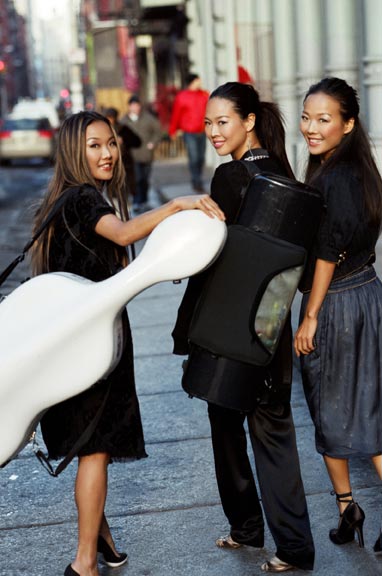Ahn Trio presents a bracing array of music by contemporary composer

The Ahn Trio performed Thursday night at Coral Gables Congregational Church.
The Ahn Trio presented an adventurous program of contemporary music before a large and enthusiastic audience Thursday night in the Coral Gables Congregational Church’s Community Arts concert series. Exceptional musicianship, meticulous layering of dynamics and tremendous energy propelled the performances.
The Korean-born sisters’ banter between numbers was reflective of the musical selections’ contrasted styles. The deep, bronze sound of Maria Ahn’s cello was set against sister Angella’s alternately sweet and edgy violin, while pianist Lucia Ahn demonstrated digital brilliance tempered by a poetic sensibility.
All of the programmed works were either written or specially arranged for the trio. American composer Kenji Bunch has been a colleague of the Ahns since they attended Juilliard together. An eclectic musical spirit, Bunch is violist of the avant garde Flux Quartet and a member of Citygrass, a New York bluegrass band. He has created scores for large and small ensembles in a variety of stylistic genres. No less than five of Bunch’s works were played by his enthusiastic advocates.
Bunch seems most comfortable incorporating elements of folk and vernacular music within a neo-Romantic soundscape. He is less successful when trying to emulate pop cultural trends.
Concrete Stream, a miniature tone poem contrasting the beauty of nature with urban bustle, opens with a bluesy cello solo. A gleaming violin melody that could have come from a Korngold score for a Hollywood melodrama is interrupted by raucous, pounding keyboard strokes channeling the contemporary industrial world. Two movements from Bunch’s Swing Shift, a portrait of late night New York originally conceived as a dance score, displayed the trio’s relentless, high-octane drive. Chopinesque piano figures support the soaring string melody of Magic Hour.
Grooveboxes depicts a DJ playing a mix in a smoky dance club. Played at a constant triple forte, the piece seemed a sterile attempt to reproduce the manic volume and fiercely pulsing rhythms of modern rock. By contrast Bunch’s arrangement of David Balakrishnan’s heavy metal Skylife was riveting, a successful translation of the power of hard-driving beats and sheer decibels.
Dies Irie (an intentional retooling of “Dies Irae,” the Latin day of wrath) and the soft Lullaby for My Favorite Insomniac are lightweight New Age ruminations that would not be out of place in a Paul Winter album. “Backstep” from the suite Danceband is a delightful simulation of Appalachian dance in the manner of Mark O’Connor. With a towel between the instrument’s strings muting the sonority, the piano becomes the sound of a banjo, with the droning fiddles evoking the robust charm of the square dance.
Displaying the Ahn’s more subtle musicality, Pat Metheny’s Yu Ryung (Ghost Figures) is a wonderful Baroque jazz vignette, mixing the melodic structure of Bach’s solo string works with contemporary modes. Paisagens Brasileiras (Brazilian Landscapes) by Nelson Ayres recall the sensuous melodies and native rhythms of Villa-Lobos. A wistful version of Jobim’s Insensatez presaged the trio’s encore — Astor Piazzolla’s Oblivion, the yearning sentimentality presented with burnished tone.
Posted in Uncategorized
Leave a Comment
Fri Jul 20, 2012
at 12:34 pm
No Comments




